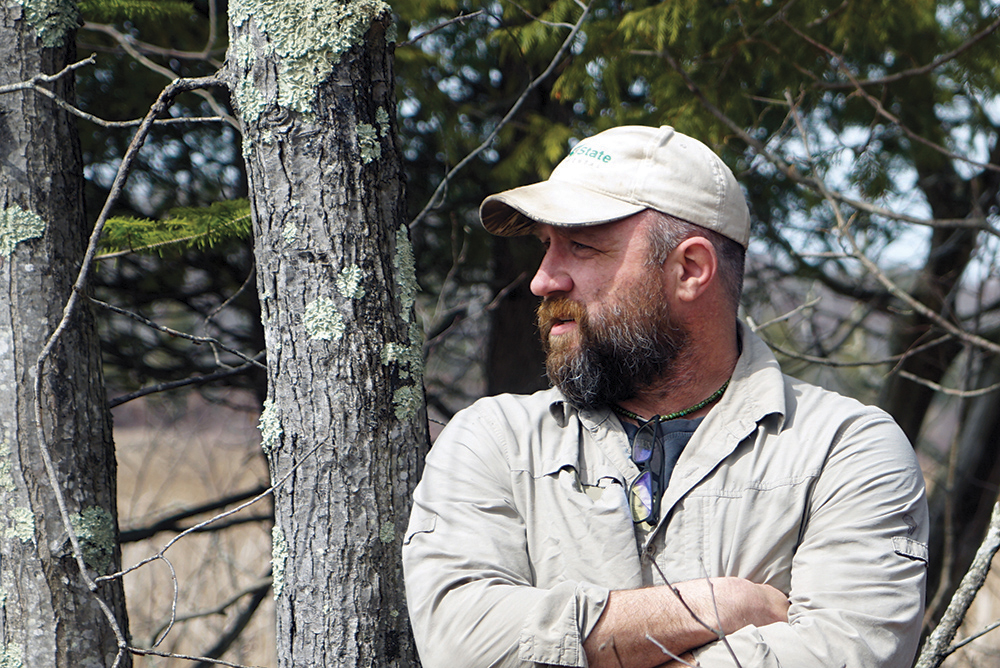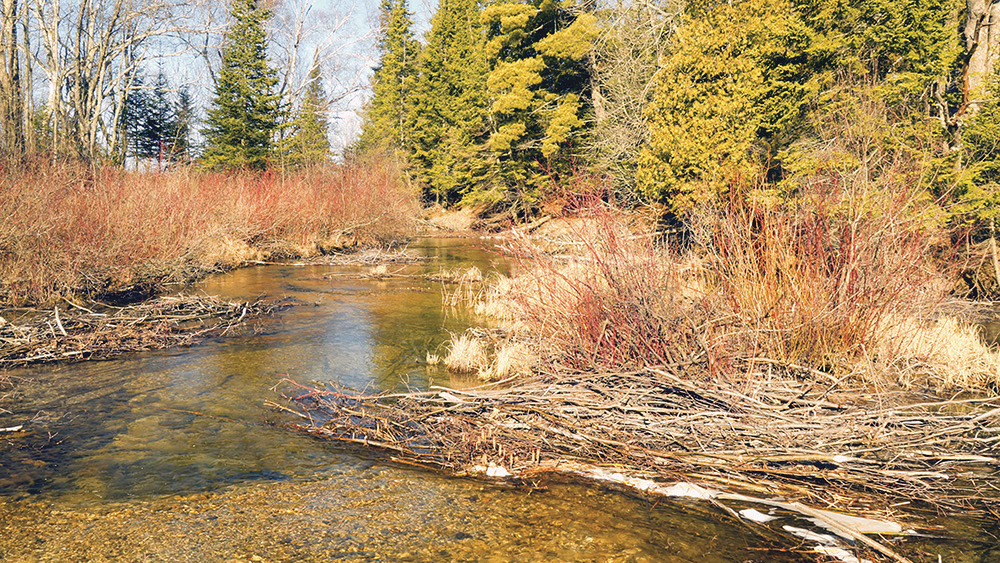An ode to brook trout and the river ecologists who study them
By Stephanie Mills
Current Contributor
When your heart wells and you shed tears of joy, the occasion merits serious attention. In my long years of professing bio-regionalism, many such moments of pure connection with some true marvel have happened: out back on my patchwork of land; elsewhere amid prairie forbs and grasses; at the raging Pacific Ocean’s shore; and in doing creative work. Finding myself misty-eyed at last year’s Research Rendezvous lectures—given by scientists who work in the Sleeping Bear Dunes National Lakeshore—surprised me, though.
Brett Fessell, a river ecologist with Russell Clark Associates—an environmental planning and design group that belongs to the Grand Traverse Band of Ottawa and Chippewa Indians—was the speaker for the Research Rendezvous lecture back in September 2016, and his talk brought me to tears of joy.
Fessell’s affection for Otter Creek and its population of brook trout is plain. He has been doing a long-term study of brook trout in Otter Creek, which meanders leisurely through marshes of cedar, poplar, and alder shade, then out into Lake Michigan.
Although Fessell’s presentation was easy going, it offered a rich synthesis of his considerable knowledge of the Otter Creek watershed’s geohistory, hydrology, and ecology. As he spoke about the glacial processes that shaped the roughly five-square-mile watershed—the ancient forces that deposited the marls that conduced to the springs that cooled the pools where brook trout could spawn and mature—those dynamic earth changes became vivid and comprehensible. It was time travel, courtesy of the facts and imagination.
Fessell’s existentially serious attention to this minute but vital portion—a clean, short, little capillary—of Lake Michigan’s watershed is something wonderful but not unique. Scores of naturalists in our bio-region are fixing their minds and hearts on wild lives and landscapes.
The field scientists among them who brave the elements, discomforts, and all-season rigors of the place to study its biota and who then contribute sturdy data to public questions about how we might better coexist with those multitudes of other beings—they perform a very real service.
Moreover, jurisdictional, political, and regulatory complexity are inescapable working conditions for resource professionals, but it is surely affection that sustains them through the number-crunching, desk work, and hazards in the field. Fessell, who has worked with the tribe for 20 years, is seasoned in collaborating with a complex welter of public agencies, a tribal government, and feisty anglers. This perseverance and diplomacy also attest a consecrated life.
Fessell might not see it that way, but he seems mighty grateful to be doing what he is doing. It suits him, right down to his waders.
A Plan for the Brookies
The “brookie”—a nimble, charismatic native fish—is a prized catch. It is a versatile creature, thriving in both streams and along the coast of the Great Lakes. Coasters, the adfluvial brook trout that swim out of their native streams and into the great lake, can bulk up during the next few months or years, spent in the lake’s wide open spaces. For instance, typical weight varies from half a pound to 6.5 pounds, but a coaster that was caught in Thunder Bay a century ago weighed in at more than 14 pounds, and there have been reports of Otter Creek coasters, too, for the way to the coast is clear.
The natural continuance of brookies, Salvelinus fontinalis, is the keynote of the Otter Creek survey and any future restoration work.
A restoration plan, based on intensive study of the watershed’s hydrogeology and geologic history, led to what Fessell calls some “very fine grain design.” It is, at present, in abeyance, however, owing to shifts in the tribe’s Natural Resources Department and to the challenge of organizing support and funding.

One thing is known for certain, though—respecting nature’s own genius for balancing ecosystems and determining carrying capacity, there will be no captive breeding or stocking of fish in Otter Creek, according to Fessell.
“We don’t always know whether we’re pushing the limits of the habitat,” he explains.
The wild brook trout, inseparable from its Otter Creek habitat, is one among a community of 25 species of fishes, only four of them non-native, and countless other critters. To thrive in a stream, the brookies need, among other things, the shelter of large woody debris—also known as fallen trees—and the thermal refuge of clean, cold, upwelling groundwater. Pool depth and cover, diversity of bed forms, and undercut banks where they can abide are also of importance.
Then and Now
Otter Creek’s picturesque, low-gradient watershed—entirely contained within the national park—was hard used in the past. Historic accounts of the area tell of many streams that were so densely shaded by old-growth forest and riparian brush that their courses could only be inferred from their flowing waters’ sound.
Lovely as the area presently is, the thought of its being cloaked in vegetation so thick and abundant is fairly stunning to imagine. Those cedars would have needed centuries to mature, then could die of old age and topple into the rivers, carrying on their life’s work as large woody debris. But 19th-century logging claimed the trees, log drives scoured the stream beds, wiping out bogs and fens along the way, and the vast conflagrations of slash that followed the cut left the landscape pretty raw.
Natural history is a fine passion: there can be something clear and true of mind and heart in scientific attention, paid out of doors. In this story, it contributes to a long-term hope of seeing the flourishing of a creek and its ecology, attested by a healthy run of brook trout. It even, in its example, offers hope for our kind.
For the Tribal Council, the rehabilitation of a watershed like Otter Creek and sustaining its population of native fish would support their goals of maintaining treaty rights in the fishery, which was once and may again be important as sustenance, as well as the cultural value of participation in the mortal dance of give and take with the lands and waters of home.
The Otter Creek story’s swirl and flow of creatures, currents, patience, possibility, and commitment stirred my heart with a power of good. Listening to Fessell, whose good humor and learning were as lively and fluent as some of Otter Creek’s marly springs, I wondered if this meticulous research project—so carefully considered, if relatively modest in geographic, but not cultural and metaphysical, scope—might not also be a long-term ceremony.
It is a way of studying and honoring the land and waters as they were and are. While pledging recollection of their true nature, the purpose is not to make an aquarium or museum diorama, but through long-term, careful work to repair relationships throughout.
This goal—of healthier relations among streams, fish, and fishers—may sound “a little Pollyanna,” Fessell admits. “But I’m here to tell you that we’re making progress. That’s important. That’s what we really need to do.”
So cue those tears of joy.
A version of this story first published on NatureChange.org.




